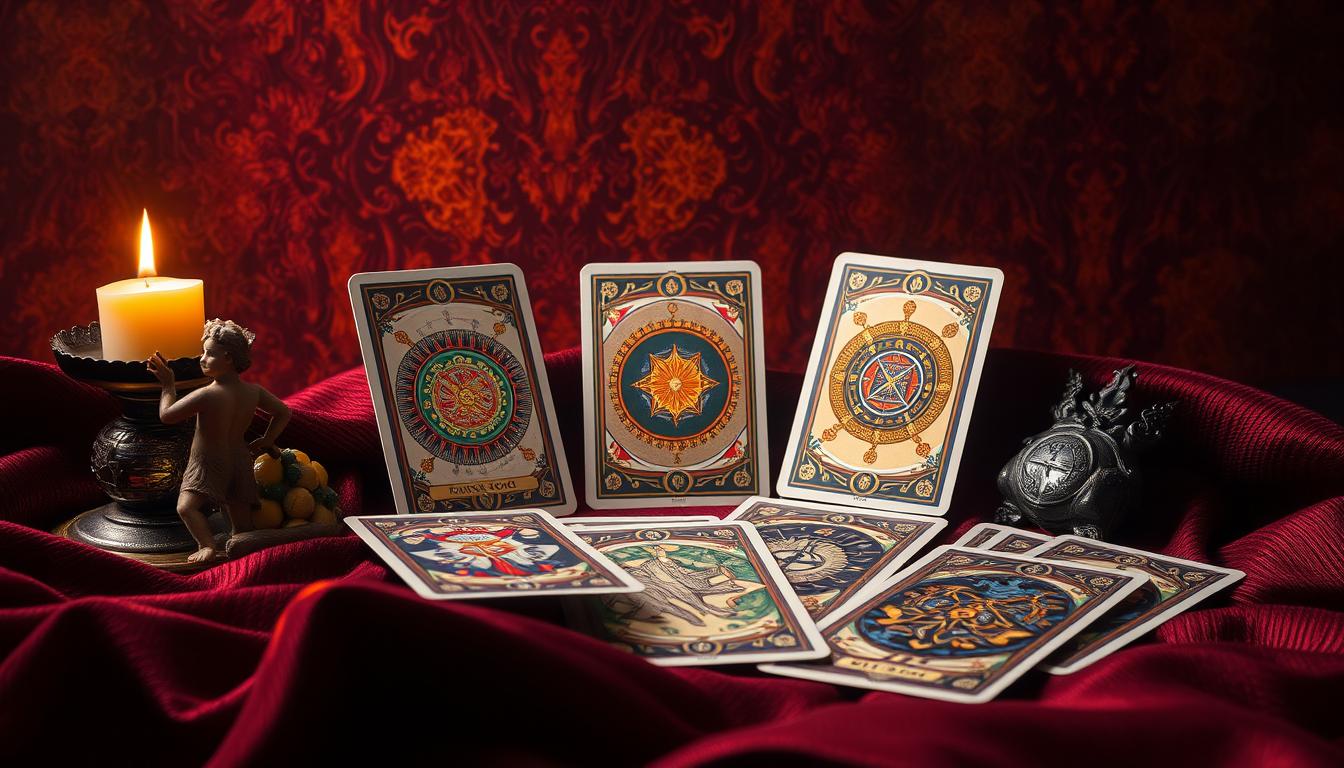Tarot cards have fascinated people for centuries, blending history, art, and symbolism into a unique tool for insight. Originating in 15th-century Italy, these cards were initially used for games before evolving into a means of divination and self-discovery. Today, they are widely embraced for their ability to reflect universal human experiences and emotions.
A standard deck consists of 78 cards, divided into the Major Arcana and Minor Arcana. The Major Arcana represents significant life events, while the Minor Arcana focuses on everyday situations. Each card carries rich symbolism, offering guidance and perspective on personal growth and challenges.
Whether you’re exploring tarot for spiritual growth or simply curious about its history, this guide will walk you through the meanings, suits, and techniques to unlock its potential. Let’s dive into the world of tarot and discover how it can enrich your life.
Key Takeaways
- Tarot cards originated in 15th-century Italy as a gaming tool.
- A standard deck has 78 cards, split into Major and Minor Arcana.
- The Major Arcana represents significant life events and themes.
- The Minor Arcana focuses on everyday experiences and emotions.
- Modern uses include spiritual growth, self-discovery, and therapy.
- Tarot symbolism mirrors universal human experiences and emotions.
Understanding Tarot: A Brief History
Originating in the 1400s, tarot decks were initially crafted for games before evolving into tools of insight. These early decks, like the Visconti-Sforza, were luxury items commissioned by noble families. They featured intricate designs and symbolic imagery, reflecting the artistic trends of the time.
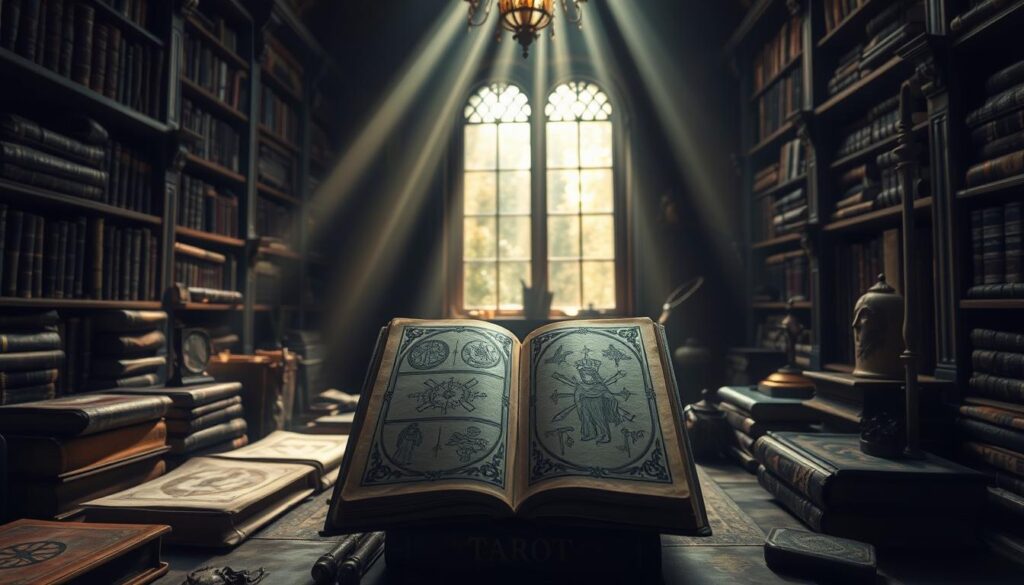
Origins and Evolution of Tarot Decks
The first known decks appeared in Italy during the 1430s. These were used for trick-taking games called tarocchi. The Major Arcana and Minor Arcana structure emerged, with 21 trionfi cards and the Fool card added to existing playing cards.
Over time, the deck evolved from hand-painted luxury items to mass-produced cards. The printing press played a key role in spreading tarot across Europe, making it accessible beyond elite circles.
From Game Cards to Divination Tools
In the late 1700s, French occultists like Etteilla began associating tarot with divination. The Tarot de Marseille, developed in the 18th century, became the standard for cartomancy. This marked a shift from games to spiritual and fortune-telling practices.
Today, tarot is celebrated for its rich symbolism and ability to reflect universal human experiences. Whether used for games or guidance, its history is a testament to its enduring appeal.
| Period | Development |
|---|---|
| 15th Century | First decks created for games in Italy |
| 18th Century | Tarot de Marseille standardizes cartomancy |
| Late 1700s | French occultists link tarot to divination |
| Modern Era | Tarot used for spiritual growth and insight |
The Structure of a Tarot Deck
The structure of a tarot deck is both intricate and symbolic, offering layers of meaning for those who explore it. A standard deck consists of 78 cards, divided into two main categories: the Major Arcana and the Minor Arcana. Each category serves a distinct purpose, reflecting different aspects of life and human experience.
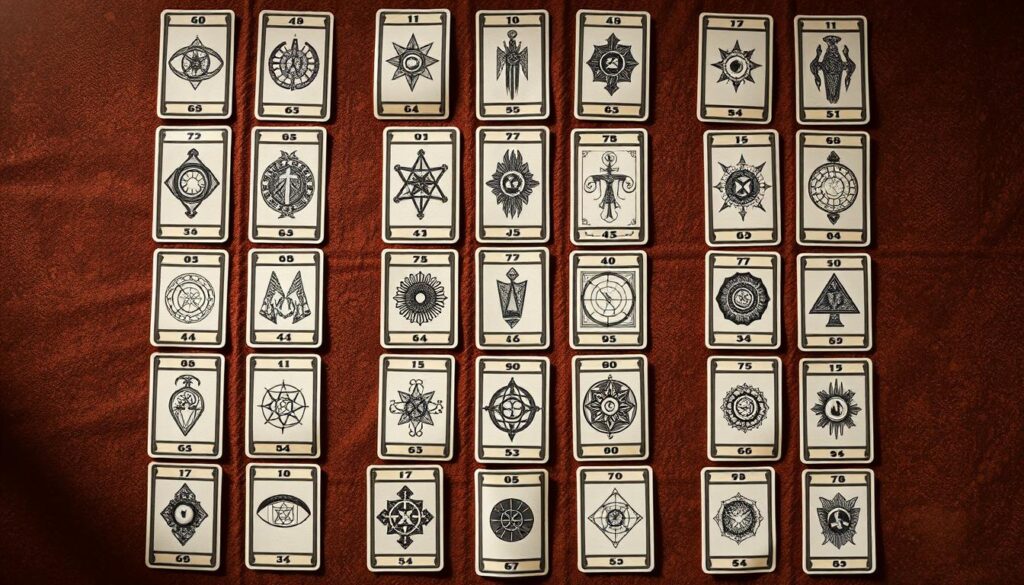
Major Arcana vs. Minor Arcana
The Major Arcana comprises 22 cards, each representing significant life lessons and spiritual milestones. These cards, such as The Fool and The World, symbolize the journey of personal growth and transformation. They are often seen as the heart of the deck, offering profound insights into life’s bigger picture.
On the other hand, the Minor Arcana includes 56 cards, divided into four suits: Wands, Cups, Swords, and Pentacles. These cards focus on everyday experiences, emotions, and challenges. Each suit contains 14 cards, ranging from Ace to Ten, plus four court cards: Page, Knight, Queen, and King.
The Four Suits: Wands, Cups, Swords, and Pentacles
Each suit in the Minor Arcana is associated with an element, which influences its interpretation. Wands are linked to Fire, symbolizing passion and creativity. Cups represent Water, reflecting emotions and relationships. Swords are tied to Air, embodying intellect and conflict. Finally, Pentacles correspond to Earth, focusing on material stability and practical matters.
The court cards in each suit add another layer of meaning. They often represent people or personalities, with a hierarchy from Page (youthful energy) to King (mature guidance). Understanding these roles can provide deeper insights into readings.
“The elements associated with each suit bring a unique energy to the cards, shaping their meanings and interpretations.”
| Suit | Element | Focus |
|---|---|---|
| Wands | Fire | Passion, Creativity |
| Cups | Water | Emotions, Relationships |
| Swords | Air | Intellect, Conflict |
| Pentacles | Earth | Material Stability |
Whether you’re drawn to the spiritual journey of the Major Arcana or the practical insights of the Minor Arcana, understanding the structure of the deck is essential. It’s the foundation for meaningful readings and personal growth.
Major Arcana Card Meanings
The Major Arcana cards are the backbone of the deck, each telling a story of life’s spiritual journey. These 22 cards represent significant life events and archetypes, guiding us through stages of growth and transformation. From The Fool’s innocence to The World’s completion, they offer profound insights into our personal and spiritual paths.
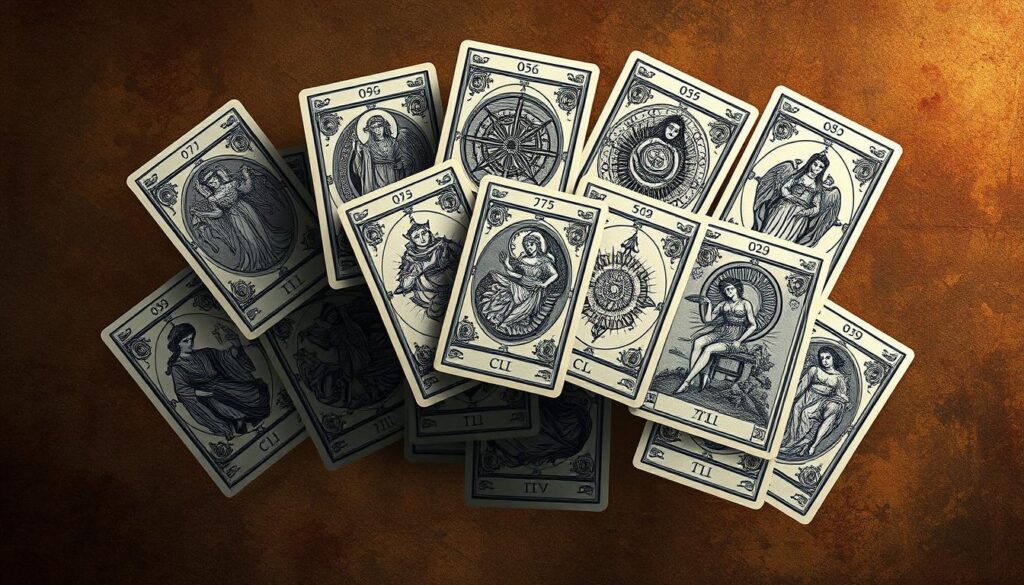
The Fool’s Journey: Life’s Spiritual Archetypes
The Fool’s journey is a metaphor for the soul’s path through life. Starting with The Fool (0), we embark on a quest filled with lessons, challenges, and triumphs. Each card in the Major Arcana represents a stage of this journey, from The Magician’s mastery to The High Priestess’s intuition and The World’s fulfillment.
This journey isn’t just about personal growth; it’s about understanding universal truths. The Fool’s path teaches us to embrace change, trust our instincts, and seek deeper meaning in our experiences.
Upright and Reversed Interpretations
Each Major Arcana card has two interpretations: upright and reversed. Upright cards reflect balanced energies, while reversed cards often indicate challenges or blocked progress. For example, The Magician upright signifies resourcefulness and personal willpower, but reversed, it may suggest misused talents or lack of focus.
Understanding these dual meanings helps us navigate life’s complexities. It allows us to see obstacles as opportunities for growth and transformation.
Key Cards: The Magician, The High Priestess, and The World
Three cards stand out in the Major Arcana for their profound symbolism. The Magician (I) represents manifestation and the power to create one’s destiny. The High Priestess (II) embodies intuition and the wisdom of the subconscious mind. The World (XXI) signifies completion, cosmic understanding, and the start of a new cycle.
These cards often appear together in readings, offering a narrative of personal growth and achievement. For example, The Magician and The World can symbolize the journey from intention to fulfillment.
“The Major Arcana is a mirror of the soul, reflecting our deepest truths and guiding us toward enlightenment.”
| Card | Upright Meaning | Reversed Meaning |
|---|---|---|
| The Magician | Manifestation, Resourcefulness | Blocked Creativity, Mismanagement |
| The High Priestess | Intuition, Hidden Knowledge | Repressed Wisdom, Blocked Intuition |
| The World | Completion, Fulfillment | Disconnection, Unfulfillment |
Minor Arcana: Suits and Symbolism
The Minor Arcana cards dive into the details of everyday life, offering practical insights and emotional guidance. Divided into four suits—Wands, Cups, Swords, and Pentacles—each represents a unique aspect of human experience. These cards help us navigate challenges, celebrate victories, and understand our emotions.
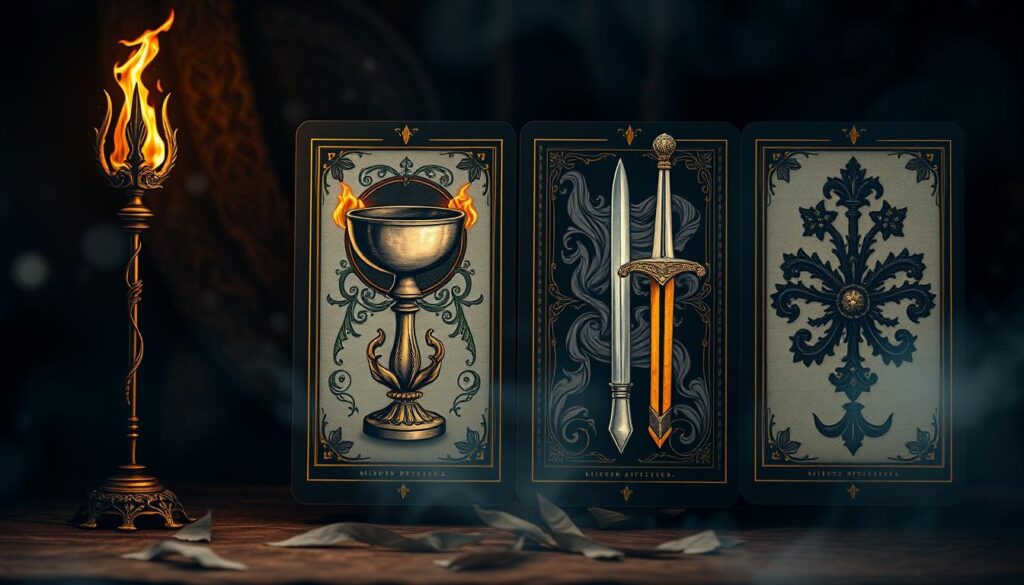
Wands: Passion and Creativity
The Wands suit is linked to the element of Fire, symbolizing energy, ambition, and creativity. These cards often appear in readings about career goals or new projects. For example, the Ace of Wands can signal a burst of inspiration, while the Knight of Wands suggests taking bold action.
In reversed positions, Wands may indicate blocked creativity or a lack of motivation. They remind us to reignite our passion and stay focused on our goals.
Cups: Emotions and Relationships
Associated with the element of Water, the Cups suit governs emotions, relationships, and intuition. These cards often appear in readings about love, family, or personal growth. The Queen of Cups, for instance, represents emotional intelligence and compassion.
Reversed Cups can signal emotional overflow or unresolved feelings. They encourage us to balance our emotions and nurture our connections.
Swords: Intellect and Conflict
The Swords suit, tied to the element of Air, focuses on thoughts, communication, and decision-making. These cards often highlight mental challenges or conflicts. The Nine of Swords, for example, is a modern symbol of anxiety and worry.
In reversed positions, Swords may suggest clarity after confusion or the need to resolve lingering disputes. They remind us to use our intellect wisely.
Pentacles: Material Stability
Linked to the element of Earth, the Pentacles suit deals with finances, work, and material stability. These cards often appear in readings about career advancements or financial decisions. The Ten of Pentacles, for instance, represents generational wealth and legacy.
Reversed Pentacles can indicate financial struggles or a need to reassess priorities. They encourage us to focus on long-term stability.
“The four suits of the Minor Arcana reflect the complexities of life, offering guidance on both practical and emotional matters.”
| Suit | Element | Focus |
|---|---|---|
| Wands | Fire | Passion, Creativity |
| Cups | Water | Emotions, Relationships |
| Swords | Air | Intellect, Conflict |
| Pentacles | Earth | Material Stability |
Understanding the suits and their symbolism can deepen your readings and provide clarity in real-life situations. Whether you’re navigating a career change or exploring your intuition, the Minor Arcana offers valuable insights. To explore more about card interpretations, visit our resource page.
How to Interpret Tarot in Readings
Interpreting tarot readings is both an art and a skill, blending intuition with structured techniques. Whether you’re a beginner or an experienced reader, understanding the process can enhance your ability to connect with the cards and uncover meaningful insights.
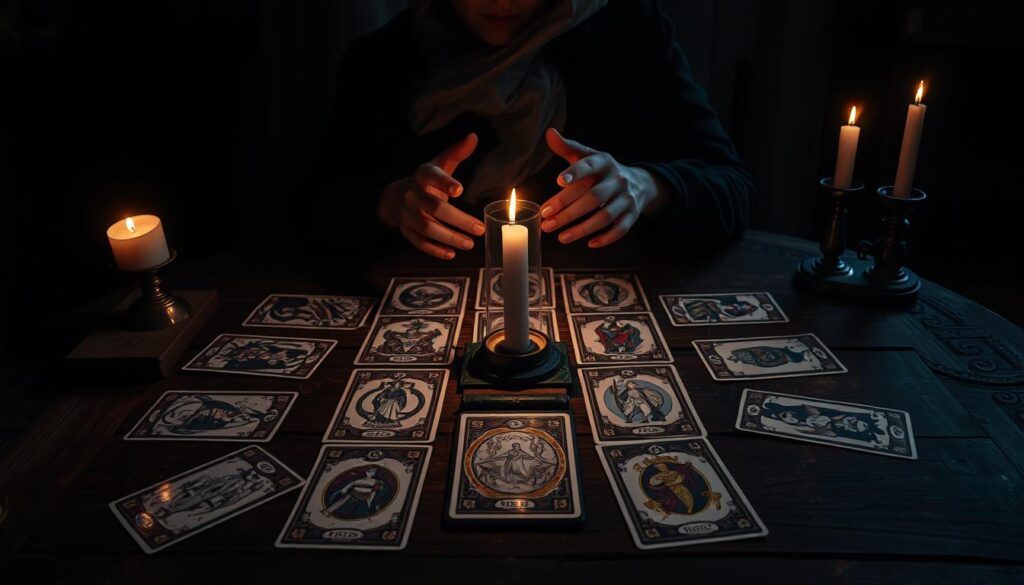
Common Spreads for Beginners
Starting with simple spreads can help build confidence. The Three-Card Spread is ideal for beginners, offering a straightforward Past-Present-Future framework. It’s perfect for quick readings and gaining clarity on specific situations.
For a more detailed analysis, the Celtic Cross spread uses ten cards to explore complex questions. This spread delves into underlying influences, challenges, and potential outcomes, making it a favorite among experienced readers.
Daily one-card draws are another great practice. They encourage reflection and help you track recurring themes in your life. Journaling these draws can reveal patterns and deepen your understanding of the cards.
Trusting Your Intuition
While book meanings provide a foundation, your intuition plays a crucial role in readings. Trust your first impressions and feelings when interpreting the cards. This personal connection often reveals deeper insights that resonate with your unique experiences.
Grounding techniques, like meditation or having a cup of tea, can help clear your mind before a reading. This ensures you approach the cards with focus and clarity, enhancing your intuitive abilities.
Balancing traditional meanings with your intuition creates a harmonious reading. It allows you to tell a cohesive story that connects the cards and provides meaningful guidance.
“Intuition is the bridge between the cards and the reader, transforming symbols into personal insights.”
| Spread | Cards | Purpose |
|---|---|---|
| Three-Card | 3 | Past-Present-Future |
| Celtic Cross | 10 | Comprehensive Analysis |
| One-Card | 1 | Daily Reflection |
Ethical considerations are also important. Avoid readings when emotionally overwhelmed to maintain accuracy and respect. Combining tarot with other practices, like astrology or numerology, can add depth to your interpretations.
By mastering these techniques and trusting your intuition, you can unlock the full potential of tarot readings. Whether for personal growth or guiding others, the journey is as rewarding as the insights gained.
Conclusion
Exploring the world of tarot offers a blend of ancient wisdom and modern self-reflection. From its origins as a game to its role in personal growth, it bridges the past and present. Developing your own interpretation style can make the experience more meaningful and relevant to your life.
For continued learning, consider resources like the Rider-Waite-Smith deck or books on symbolism. Joining communities can also provide support and shared insights. Always approach readings with an open mind and ethical practices, ensuring respect for yourself and others.
Tarot is more than a tool—it’s a mirror for self-discovery. Its timeless symbols connect us to universal truths, offering guidance in health, family, and personal growth. Whether you’re a beginner or seasoned reader, the journey is as enriching as the insights gained.

